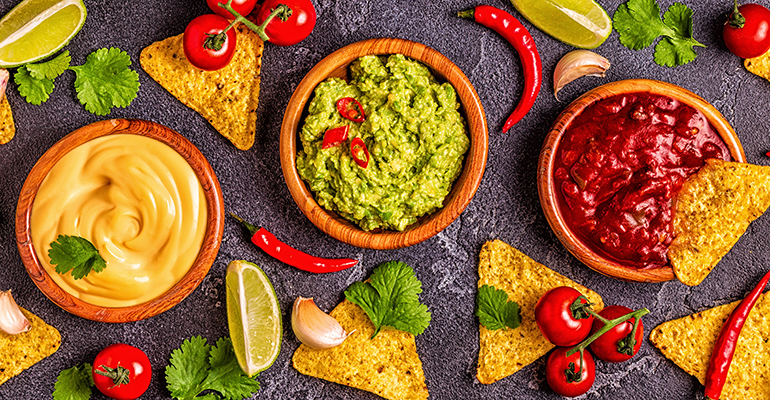News
‘Exciting, flavourful and adventurous’: Latin American flavours are on-trend in the US
20 Aug 2021Seen as exciting, flavourful and adventurous, Latino flavours are popular in the US, according to Mintel research. Does this open up export opportunities for healthy Latin American food brands?
Upcoming research from market insights company Mintel reveals that US consumers see Latin cuisine as exciting, flavourful and adventurous and that a majority of US consumers eat Latin cuisine, with one third doing so regularly.

However, this on-trend status comes with a caveat: US consumers do not necessarily perceive Latin American cuisine as healthy despite the fact it can be packed with fruit, vegetables, and pulses. Mintel consumer insights analyst Alyssa Hangartner suggests brands can address this by highlighting the lighter, healthier side of Latino food, particularly by aligning their products with current health trends, such as nutrient density and plant-based options.
“Millennials and Gen Z are more likely than their older counterparts to pick up on the healthy side of Latin cuisine and also describe Latin flavours as exciting and premium. This suggests that more than just flavours influence their Latin cuisine experiences. Fresh, premium ingredients that deliver authenticity and adventure resonate with these consumers,” she says.
“Many authentic Latin cuisines can be both plant-based and nutrient-dense featuring fruits, vegetables, grains and beans. In addition, thoughtfully crafted preparation styles and utilizing traditional ingredients will curate a premium and authentic experience. Positioning future innovation at the crossroads of authenticity and health will deliver on the adventure consumers are looking for, without sacrifice.”
A number of US brands are successfully leveraging these associations already, Mintel notes. Barnana, for instance, is a US brand that makes plantain chips and banana-based bars in the US using upcycled bananas and plantain grown in Central and South America. Its chips are available in typical Latin American flavours such as spicy mango salsa and Acapulco lime while the bars contain native fruit such as goldenberry.
Exploring export opportunities
But are there opportunities for home-grown Latin American brands to tap into this trend and find success by exporting their products to the US? The US has a significant Hispanic population – 60.6 million in 2019, according to US Census Bureau data – and, with the right positioning, authentic Latin American products could appeal to this demographic and beyond.
Mario Carrasco is co-founder and principal of ThinkNow, a US-based market research agency that specialises in the cultural drivers influencing consumer decisions. ThinkNow partnered with Abasto, a platform for Hispanic food industry entrepreneurs in 2019, to gain insights into how US Hispanic people view Latin American brands. It found that almost 60% of US Hispanics say they are more interested in a brand’s products if the brand comes from Latin America.
However, just being from a Latin American country is not enough. Consumers, particularly Millennials and Gen Z consumers (a demographic that makes up a large proportion of the US Hispanic population) are looking for authentic food and drink brands, Carrasco notes.
Interestingly, ThinkNow’s research revealed that only 14% of US Latinos associated authenticity with a brand’s relevance to their country of origin or cultural heritage. More important was having a well-known brand and, for 86% of those surveyed, a great tasting product.
“Looking at […] the findings, we gather that, for Latin American brands, ‘authenticity’ carries additional nuances. Their customers want an experience congruent with their cultural identity,” Carrasco writes in a Marketing Insider commentary.
“Many younger US Hispanics were born here and may have never been to Latin America. Yet, they have experienced the rich culture through stories told and recipes made by their first-generation relatives. They want a product with quality ingredients: one that satisfies the palate and evokes memories of their country of origin’s kitchen. Brands that enter a market with this type of detail in their ideal customer profile will be much more likely to succeed,” he says.
Using native ingredients
Using native ‘superfood’ ingredients may be one way to combine this desire for tasty, quality ingredients that evoke the continent’s culinary heritage.
From açaí in Brazil and maqui in Chile; kiwicha (amaranth) and maca root in Peru to heirloom criollo corn in Mexico, Latin American brands are increasingly adding native ingredients to packaged products to appeal to domestic consumers, and these ingredients could also appeal to US consumers, Latino or otherwise.
Ecuadorian brand LiveKuna, for instance, uses chia and quinoa to make healthy popped chips with added probiotics and low-sugar breakfast cereal. Exports to the US and Canada make up around 50% of its sales with the remaining 50% sold domestically and in other Latin American countries.
Mexican brand Deliyum makes vegan fig and maca boost bites, with Andean maca root powder that is said to improve energy levels, and high-fibre nopal cactus snacks flavoured with guajillo chili and lime.
Hangartner concludes: “Latin flavours and ingredients are ripe for brand exploration, especially if they can reinforce a relationship between enjoyment and better-for-you (BFY) snacking.”
